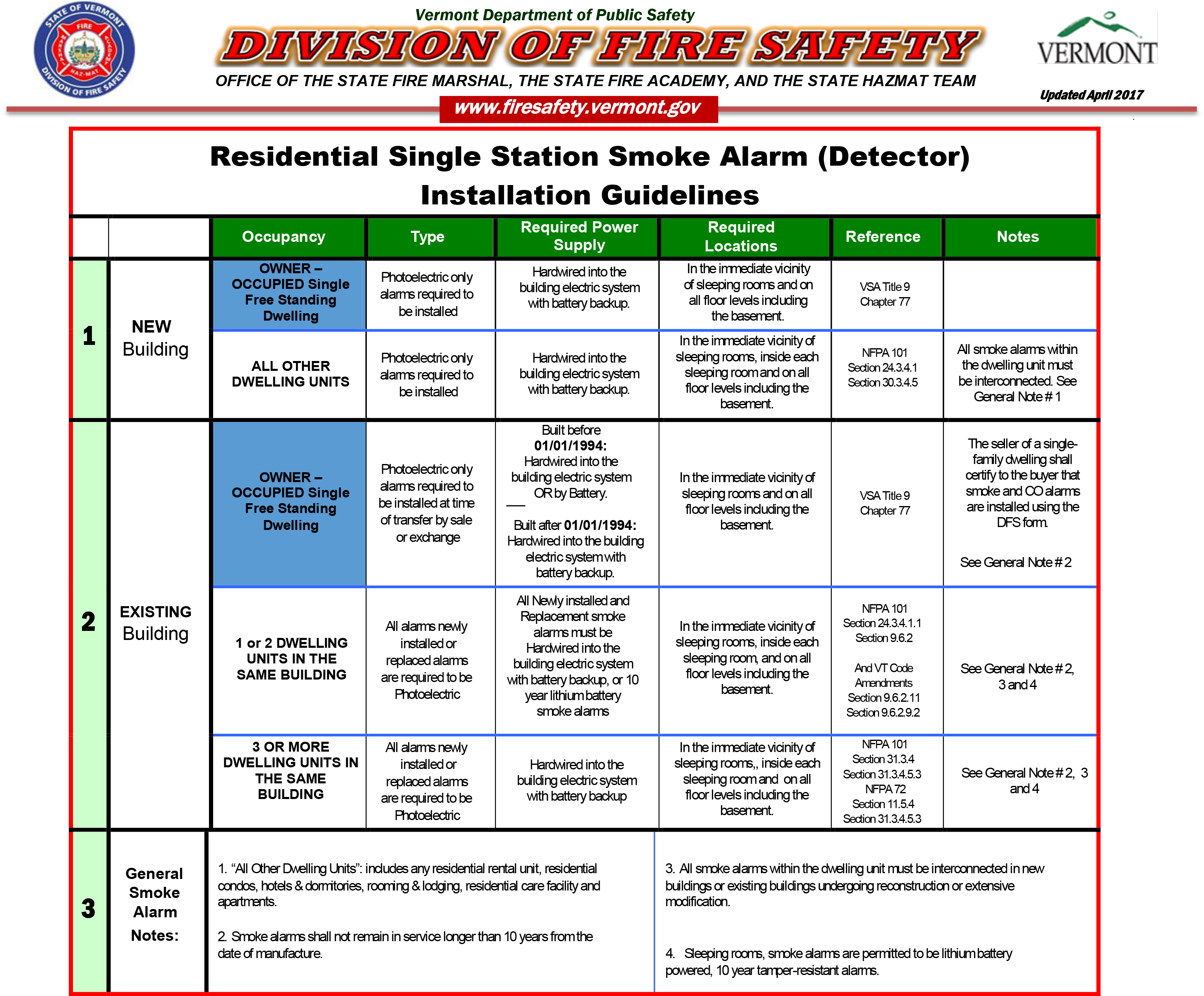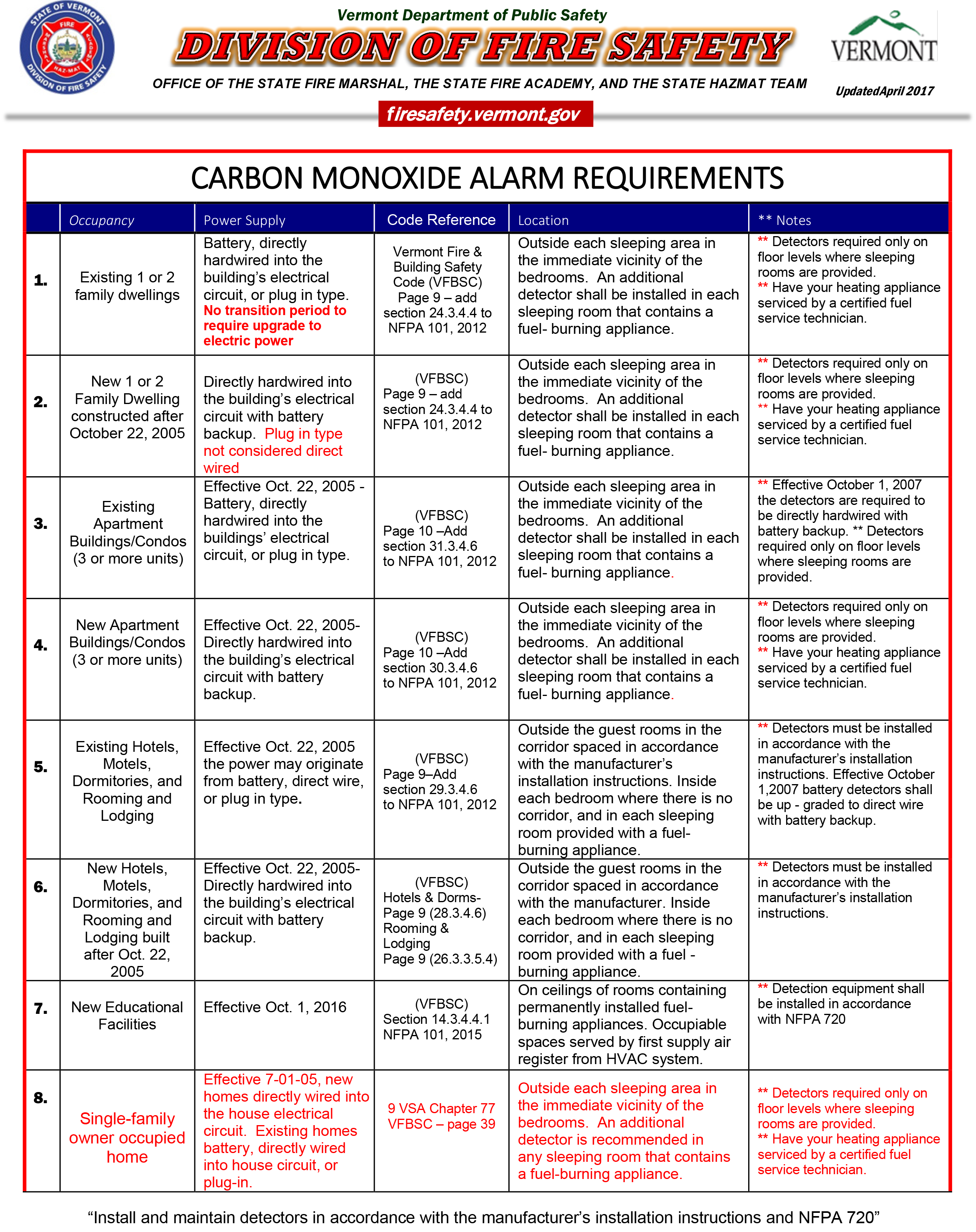Working smoke and carbon monoxide (CO) alarms are the most important devices you can have in your home. They provide essential early warnings of a problem so you and your family can safely escape.
Vermont law has required smoke detectors (alarms) to be installed in single-family dwellings since 1994. Smoke alarms have been required to be installed in multi-family and rental dwellings for more than 30 years.
One common factor in most fatal fires is the lack of properly installed, and working smoke alarms. More than one smoke alarm is needed in most dwelling units to make sure that people can hear the alarm and have time to escape. Smoke alarms need to be properly installed, maintained and replaced when needed.
Frequency for Testing Smoke and Carbon Monoxide Alarms
Smoke and CO detectors should be tested every month. Most detectors allow you to press a test button (some may need to be held for a few seconds) on the unit. If your detector has replaceable batteries, the South Hero Volunteer Fire Department recommends replace them at twice each year.
Although you replace your batteries, carbon monoxide alarms don’t last forever. They have a lifetime of anywhere between 5 to 7 years, but it is important to check the specific product for lifetime.
Smoke Detectors
Make sure your smoke detectors are using the correct technology. The Vermont Division of Fire Safety requires all smoke detectors to use photoelectric sensors to detect smoke, and to be hardwired in all places of residence except homes built before 1994.
See the chart below for state requirements:

Why do you need photo-electric type alarms?
Photo-Electric as their name implies use a photo-cell to look through a sampling of air, the alarms detect visible particles of smoke and are faster at detecting slow-burning, smoldering fires, up to 90 minutes faster than ionization. The NFPA has some great guides as to how both technologies work:
Learn how Photo-Electric Smoke Detectors Work
Learn How Ionizing Smoke Detectors Work
Vermont requires at a minimum of one smoke detector per floor level (including the basement) as well as a smoke detector in the immediate vicinity of and sleeping rooms. The smoke detector near sleeping rooms can count for the smoke detector required per floor, but if sleeping rooms are not adjacent, multiple detectors may be required on the same floor.
Non-Emergency Chirps
Smoke detectors will emit a non-emergency chirp every couple of minutes primarily for two reasons. The first is for a low battery, if you have replaced the battery and it is still chirping it may be because your detector is expired, Smoke detectors should be replaced every 10 years and some models will alert that their time is up. There should be a manufactured date or expiration date on the back of the detector to let you know when you need to replace it.
Carbon Monoxide Detectors
Carbon Monoxide (CO) is an odorless, colorless gas that displaces Oxygen in our bodies. Some symptoms you may experience are Headaches, Weakness, Shortness of Breath, Dizziness, Nausea or Vomiting, Confusion, Blurred Vision, even Loss of Consciousness and death. If you experience any of these symptoms and suspect CO may be the cause, evacuate the space immediately, then call 911.
A common behavior we see on the Fire Department is people will try ventilate their homes, opening all the windows to try and flush the house out. This is putting yourself at a much greater risk staying inside the space, and will make identifying the source much more difficult. Many CO calls we respond to where the windows have been opened have the CO levels have dropped to an undetectable level. If the CO leak is small, even after we have closed your windows and doors, the levels may not build back to a detectable level until after we have left the property.
A myth about CO is that it will sink to the floor. While CO is heavier than oxygen molecules, air is not made up solely of oxygen. In reality, CO is slightly lighter than air, however, it is close enough that CO will mix with the air and be more affected by warming/cooling air currents than by gravity alone. Since most sources of CO are heating appliances (Stoves, Furnaces, Ovens, etc.) the CO will be mixing with warm air will rise and be detected by a combination smoke/CO detector
Where to Place CO Detectors
CO Detectors are required outside each sleeping area (same as smoke detectors), as well as INSIDE any sleeping rooms with fuel-burning appliances (like a wood-stove, fireplace, or propane stove, etc.). CO detectors are required to be hardwired in homes built after October 2005.
Because CO detectors and smoke detectors are required in many of the same location as smoke detectors, manufacturers make combination Smoke and CO detectors. These combination detectors generally only have one type of smoke detecting technology in them so make sure its photoelectric and CO to be compliant with Vermont laws.
Some fuel-burning appliances may give off a small amount of CO as part of their startup (for example: a pellet wood stove may give off a little bit until the flue warms up and a positive draft is established). Because of this it is recommended that CO detectors are placed at least 15 feet away from any fuel-burning appliance if possible to avoid false-alarms. In bedrooms with fuel burning appliances this may not be possible, but should be located as far away from the appliance as possible.
Below is the chart from the State of Vermont on CO detector requirements:

